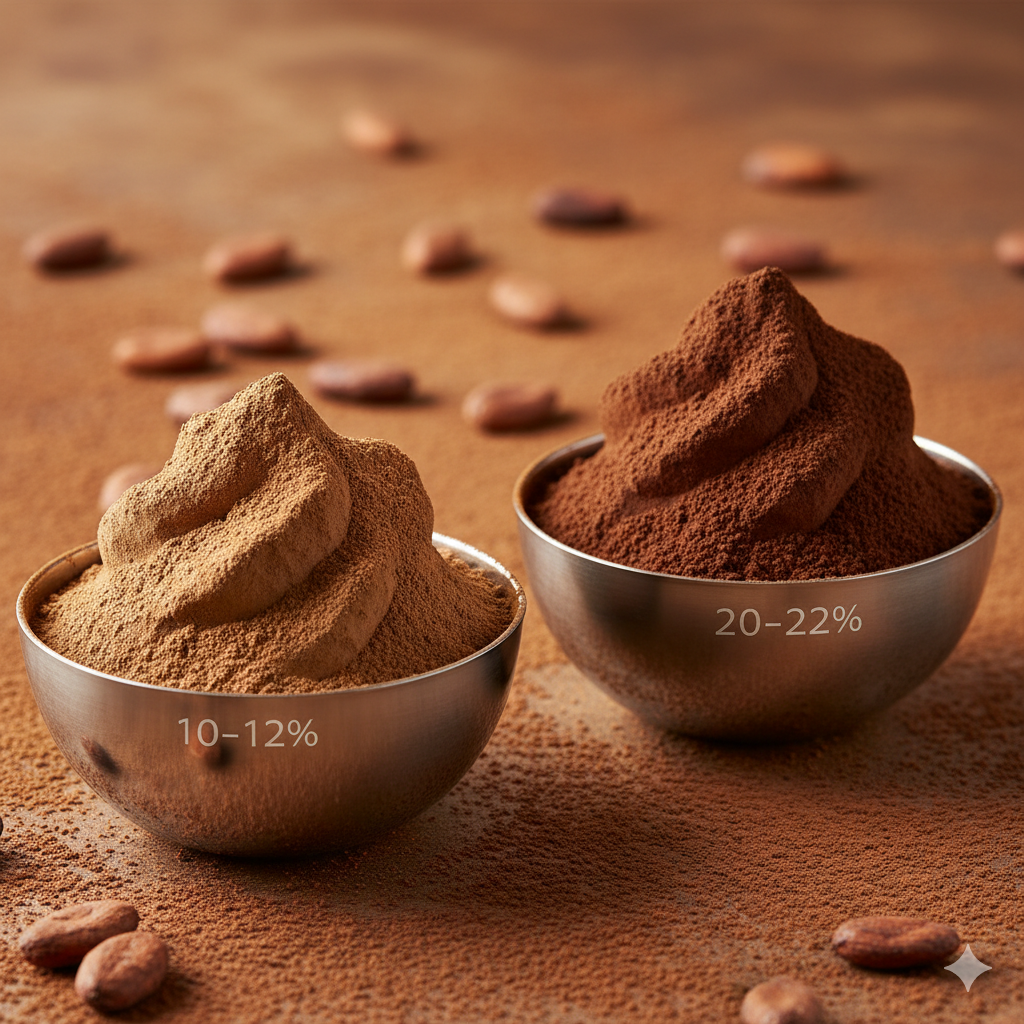
Choosing between 10–12% fat (low-fat) and 20–22% fat (high-fat) cocoa powder can make or break the sensory profile, processing behavior, and cost-in-use of your finished goods. While both start as cocoa cake milled to powder, their residual cocoa butter content drives major differences in mouthfeel, flavor carry, dispersion, and stability. Use this guide to map each grade to the right application—so your R&D approvals move faster and your procurement stays efficient.
Cocoa powder’s fat is the natural cocoa butter that remains after pressing.
10–12% fat: more defatted, leaner mouthfeel, typically easier to disperse in water systems and more cost-effective per color-intensity unit.
20–22% fat: higher cocoa butter content for richer body and flavor retention, sometimes slightly slower hydration but superior creaminess in dairy and indulgent applications.
Mouthfeel & flavor carry: Fat is a flavor carrier. High-fat powders (20–22%) amplify chocolate perception and lingering notes—ideal for ice cream, premium hot chocolate, desserts, fillings. Low-fat (10–12%) gives a cleaner, lighter profile—great for instant beverages, cereals, and biscuits where quick dispersion and crispness matter.
Color impact: With comparable alkalization levels, both can reach similar color targets, but high-fat often looks slightly deeper and more uniform in fatty matrices. Low-fat can deliver strong color efficiency at lower cost in baked goods and dry mixes.
Dispersion & wetting: 10–12% typically hydrates faster in water-based systems and cold processes. For RTD chocolate milk or instant cocoa mixes, this can reduce mixing time and clumping.
Structure & texture: In bakery, low-fat supports crisp textures in cookies and wafers; high-fat moves textures toward tenderness and richer bite. In ice cream, 20–22% integrates seamlessly with the dairy fat system to elevate creaminess.
Stability: Higher fat may increase the risk of oiling-out in very low-fat bases if not balanced; low-fat is often better for spray-dried mixes and applications that need long shelf life in humid climates.
Beverages (instant & RTD): Choose 10–12% for faster dispersion and economical color. If you want café-style richness or are working with dairy bases, test a 20–22% variant for premium mouthfeel.
Cookies, wafers, and dry bakery: 10–12% is the default for crisp structure and cost efficiency. For indulgent brownies or cakes, consider 20–22% to boost moistness and chocolate perception.
Ice cream & dairy desserts: 20–22% excels by enhancing body and flavor carry; it harmonizes with milk fat and stabilizers for a smooth finish.
Confectionery fillings & spreads: The higher butter phase in 20–22% helps round bitterness and extend cocoa notes.
Breakfast cereals & granola: 10–12% keeps coatings snappy and less greasy while still delivering color.
Fat % doesn’t work in isolation. Pair your target fat with the right alkalization grade (Brown, Dark Brown, Very Dark, Black) to lock in pH and color. For bakery using baking powder systems, alkalized cocoa is often the better fit; for soda-leavened recipes or clean-label targets, natural cocoa may be preferred—though many formulators still select alkalized 10–12% for its predictable dispersion and stable hue.
Ask your supplier for:
CoA per batch: pH, moisture, fat %, fineness (% through 200-mesh), microbiology, and heavy metals summary.
Color data: L*a*b* at a standard dosage, so you can match against your current formula.
Dispersibility notes: Especially for instant/RTD; include any lecithination recommendations.
Packaging: 25 kg paper bags with inner PE liner, pallet pattern, date code, and storage guidance.
Compliance: Halal statement, ISO-aligned food-safety controls, non-GMO and allergen statements.
Want economical color, quick hydration, and crisp textures? Start with 10–12%.
Want luxurious body, longer flavor, and premium positioning? Start with 20–22%.
Unsure? Run side-by-side trials at equal color targets; compare viscosity, flavor intensity, and cost-per-batch.
Share This News